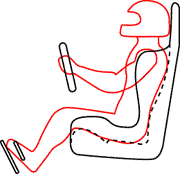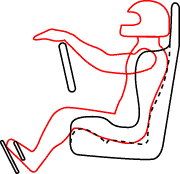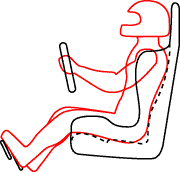Article Topics:
- Overview
- Intro to Racing
- Driving Technique
- Practice Sessions
- Driver’s Gear
- Vehicle Safety
- Handling
- Brakes
- Power
- Tools
TurnFast
recommends
these books:
Articles about Driving Techniques
Racing Seats and Seating Position
One of the first things to prepare before you even turn the key, is a proper seating position. This is often overlooked, or improperly immitated, resulting in poorer car control and premature fatigue.
If you look at a variety of race cars, you will see a variety of seating positions. In the open-wheel CART and Formula cars, it appears that the driver is almost laying down with arms fully oustretched (they are not). In a full-bodied NASCAR-type car, you see the driver more upright and almost cramped against the steering wheel. Neither position is the correct one for your street car in road racing.
The body of the open-wheel car is very shallow in height, and the cockpit is very narrow. This shape determines much of the driver's position. The driver's legs are relatively straight out with a slight bend in the knee, and the feet just barely below the hips. The pedals in many of these cars are almost touching each other. The pedals also require little more than a flexing of the ankle to go from 0-100% depression. The driver's arms have little room for movement, but the steering requires extremely little turning input by the driver. In the open-wheel car, function (driver's seating position and controls operation) follows form (the shallow and narrow cockpit).
In a NASCAR type car, many things are completely opposite. The driver sits very upright, and is very close to the steering wheel. In fact, the driver can almost lay his whole forearm on the steering wheel. Why the big difference? The cars themselves are larger, heavier, and have large front tires. Additionally, on even the large speedway tri-ovals, the percentage of time spent turning is much higher than on a road course. All this adds up, and means the driver's right arm and shoulder is going to get tired much sooner. Sitting upright and close to the steering wheel allows the driver to utilize more of the shoulder and back muscles.
In driving a street car on a road course, whether the car is stock or fully race-prepared, neither of the above described seating positions is correct. The seat should not be "layed down" to make you look like a formula driver, and neither should sit as close as the NASCAR driver.
There are three main aspects to setting the correct seating position. Each of these is described under the illustrations to the right. In a street car, it is possible that some balanced compromise of these three parameters is needed as the fixed position of the pedals and steering wheel may not be perfectly matched to your arm and leg lengths. In a race car, or a street car you spend the money on, the pedal arms can be modified, and a steering wheel with a specific dish dimension (the depth of the mounting plane to the face of the handling ring) can be selected to allow a perfect match to your needs.
Read Next Article (Steering)
Tags: Race Seats, Racing Steering Wheels, Competition Seat Belts

First, sitting in the seat itself, the driver's back should be flat against the back of the seat with the buttocks squarley tucked into the corner created at the intersection of the seat back and bottom. The underside of the legs should be in contact with the seat bottom. The purpose of this position is to provide as much surface contact between the driver's body and the seat. This has safety benefits as well as providing the driver with the most tactile feedback as possible.

Second is the arm position. When the driver is tightly strapped into the seat as described above, the arms when fully extended should allow the wrists to rest at the top of the steering wheel. This allows the arms to be slightly bent at the elbow when fully extended for a turn. The purpose of this position is to prevent the arms from being overextended during turns (the shoulders should not need to lift from the seat back even to do a full arm crossover). Overextending the arms will cause them to tire quickly, and will cause the driver to lose sensitivity to the vibrations in the steering wheel.

Third is the leg position. When any of the pedals are fully depressed with the ball of the foot on the pedal (not the toes), the leg should still be bent at the knee. This is to prevent overextension as described for the arms. Additionally, given that most hobbists are driving their street cars, be sure that the knees are not against the underdash or steering column. In fact, there should be several inches room to prevent injury in event of a collision. The right leg in particular will need enough knee room to allow the ball of the foot to be on the brake pedal, and the heel to be on the gas pedal for heel-toe downshifting.
